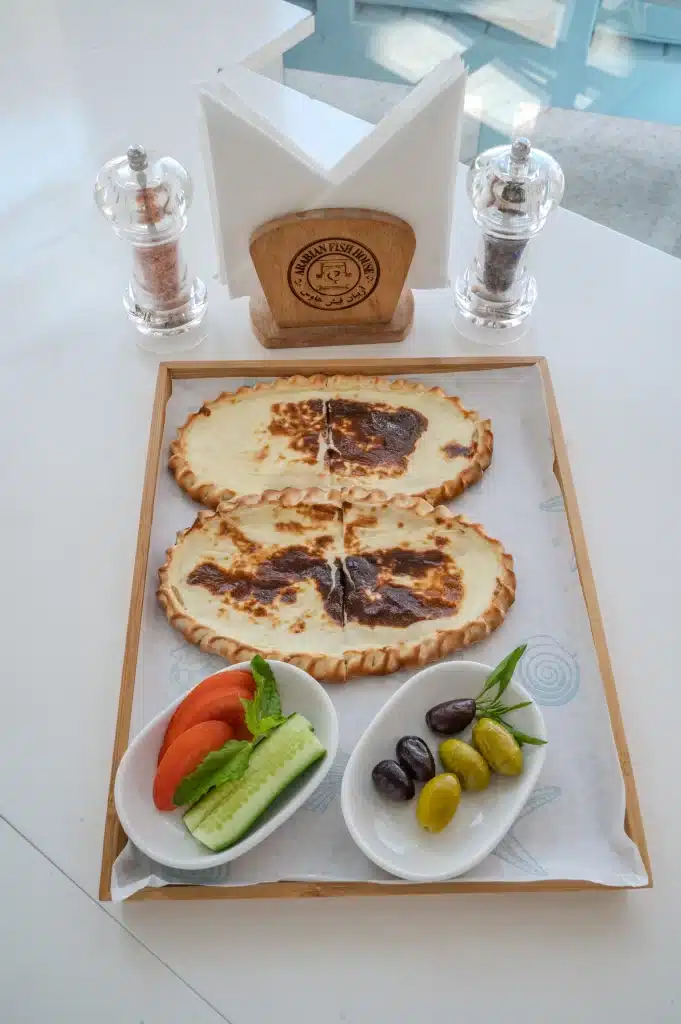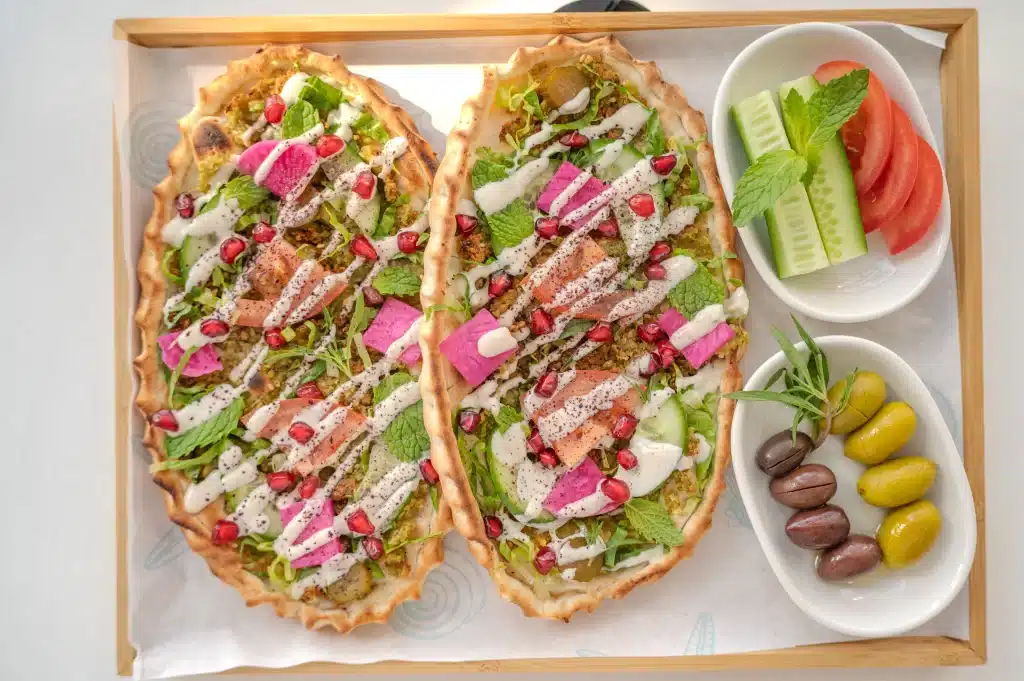The Secret to Our Delicious Manakish: Our Freshly Made Dough and Toppings
Introduction:
Fresh Lebanese manakish is a delicious and popular Levantine dish that originated in Lebanon and gained popularity throughout the Middle East. It is a type of flatbread topped with various ingredients and baked to perfection.
- Manakish is typically made with a dough that is stretched or rolled out into a thin disc. Then, topped with a flavorful combination of ingredients before being baked in a hot oven.
Fresh manakish is often adorned with a variety of toppings, such as za’atar (a mix of dried herbs, sesame seeds, and spices), cheese, minced meat, or a combination of ingredients like tomatoes, olives, and herbs. The toppings add layers of flavor and texture to the bread, creating a mouthwatering experience. It is called manakish or manakeesh or manaeesh, or mankoushe.
History of Manakish:
The history of Arabic manakish is deeply intertwined with the culinary traditions of the Levant region. Which encompasses modern-day Lebanon, Syria, Jordan, and Palestine. While the exact origin of manakish is difficult to pinpoint, its roots can be traced back thousands of years. making it a dish with a rich historical heritage.
- The concept of flatbread topped with various ingredients has existed in the Levant region since ancient times. The Phoenicians, an ancient civilization that thrived along the eastern Mediterranean coast. They are believed to have played a significant role in the development and spread of this culinary practice. They were skilled traders and navigators, establishing maritime routes that facilitated the exchange of goods and cultural influences.
Over time, manakish evolved and adapted to the tastes and ingredients available in different regions. It became a versatile dish that reflected the cultural diversity and influences of the Levantine people.
The beginning of the Fillings:
Fillings used in manakish were influenced by the agricultural produce, herbs, and spices that were abundant in the region. The Lebanese breakfast meal “Manakish” gained popularity as a staple food, particularly in villages and towns where communal ovens were used for baking. It was a practical and delicious way to nourish communities, and the aroma of freshly baked manakish would permeate the streets. Creating a sense of warmth and togetherness.
How manakish was made for the first time?
Throughout history, one of the best arabian breakfast dishes manakish has been enjoyed as a part of daily life. It has been passed down through generations, with families preserving their unique recipes and techniques. The communal aspect of baking and sharing manakish has helped foster a sense of community and connection. Today, manakish continues to hold a beloved place in the hearts and palates of the Levantine people. It has also gained recognition and popularity beyond the region, with Middle Eastern communities around the world embracing it as a symbol of their heritage.
The history of manakish is a testament to the enduring nature of traditional dishes and their ability to transcend time and borders. It represents the rich culinary legacy of the Levant, showcasing the ingenuity, resourcefulness, and cultural vibrancy of the people who have cherished and nurtured it for centuries.
Versatility of fresh manakish:
One of the highlights of fresh manakish is its versatility. It can be enjoyed as a breakfast dish, a quick snack, or even as a main course. The warm, aromatic bread paired with the savory toppings creates a delightful combination that satisfies both hunger and cravings.
- Fresh manakish from the levantine cuisine is best enjoyed straight from the oven when the bread is still warm and the flavors are at their peak. It’s simple yet comforting nature has made it a beloved dish in Middle Eastern cuisine, and it continues to be a go-to choose for those seeking a delicious and satisfying meal.
Toppings and flavors of Manakish:
Fresh manakish is levantine breakfast renowned for its versatility, offering a wide range of possibilities in terms of toppings and flavors. Here are some aspects that highlight the versatility of this delectable Levantine dish:
- Topping Variations: Fresh manakish can be customized with a variety of toppings to suit different preferences. From classic choices like za’atar, cheese, and minced meat to more creative combinations such as vegetables, herbs, or even sweet toppings like Nutella or honey, the possibilities are endless. This versatility allows individuals to create their own unique flavor profiles based on personal preferences and dietary restrictions.

Meal options to choose from them:
Manakish can be enjoyed at any time of the day, making it a versatile option for various meals. It can be served as a hearty breakfast, a quick and satisfying lunch, or even a light dinner. Its adaptability lends itself well to different eating occasions and dietary needs.
- Portability: Fresh manakish is highly portable, making it a convenient choice for on-the-go meals or snacks. It can be easily wrapped or folded, making it an ideal option for packed lunches, picnics, or as a quick bite during busy days.
- Pairing Possibilities: Fresh manakish can be paired with a variety of accompaniments, enhancing its versatility. It can be served with traditional side dishes like labneh (strained yogurt), pickles, or fresh vegetables. And even incorporated into sandwiches or wraps for added texture and flavor.

Adaptability to Dietary Restrictions:
Fresh manakish can be easily adapted to meet specific dietary requirements. For example, gluten-free or vegan versions can be made using alternative flours or plant-based ingredients. Ensuring that a wider range of individuals can enjoy this delicious dish. In summary, the versatility of fresh manakish lies in its ability to be customized with a variety of toppings. Its suitability for different meals, its portability, its compatibility with various accompaniments, and its adaptability to dietary restrictions. These qualities make it a versatile and satisfying choice for individuals seeking a versatile and flavorful culinary experience.
How to put Manakish in your diet plan:
Including manakish in our diet can be a flavorful and enjoyable way to incorporate a variety of ingredients and nutrients into our meals. Here are some aspects to consider when including one of the breakfast dishes manakish in your diet:
- Moderation: While manakish can be a delicious addition to your diet, it’s important to consume it in moderation. Since manakish is typically made with bread, it can be higher in calories, carbohydrates, and fats. Being mindful of portion sizes can help maintain a balanced diet.
- Whole Grain Options: This can increase the fiber content and provide more sustained energy. Whole grains are also rich in vitamins, minerals, and antioxidants, making them a healthier choice.
- Toppings and Fillings: Choose a variety of toppings and fillings to add flavor and nutritional value. Consider incorporating fresh vegetables, herbs, lean proteins like grilled chicken or fish, and lighter cheese options.
Balance the rate of eating manakish:
Pairing the Levantine breakfast Manakish with fresh salad or vegetables can help balance the meal and add more nutrients. This can contribute to a well-rounded and nutritious diet. Making manakish at home allows you to have control over the ingredients and portion sizes. With healthier alternatives, such as using whole wheat flour, reducing the amount of oil, or opting for lower-fat cheese options. Manakish can be a part of a diverse and enjoyable diet. By varying the toppings and fillings, you can explore different flavor combinations and keep your meals interesting. Remember, it’s important to consider manakish as part of an overall balanced diet that includes a variety of foods from different food groups. Moderation, portion control, and mindful eating practices are key to maintaining a healthy and enjoyable relationship with food.
The preparation of manakish:
Involves several key techniques that contribute to its unique texture and flavor. Here are some important aspects to cover when discussing the preparation techniques of manakish:
- Dough Preparation: Manakish dough is typically made using a combination of flour, water, yeast, salt, and sometimes olive oil. The ingredients are mixed and kneaded until a smooth and elastic dough is formed. The dough is then left to rise, allowing the yeast to activate and create air pockets for a lighter texture.
- Shaping and Stretching: Once the dough has risen, it is divided into smaller portions and shaped into individual discs. Traditionally, the dough is stretched by hand, using a technique that involves gently pulling and stretching it from the center. Towards the edges, creating a thin and even round shape. Alternatively, a rolling pin can be used to achieve the desired thickness.
Eat it on your own way:
- Topping Application: After shaping the dough, the toppings are added. This can include a variety of options such as za’atar, cheese, minced meat, or vegetable combinations. The toppings are generously spread over the dough, ensuring even coverage and a balanced distribution of flavors.
- Baking: Manakish is traditionally baked in a hot oven, often on a stone or baking sheet. High heat allows the dough to rise further and develop a crispy exterior while maintaining a soft and chewy interior. The baking time may vary, but typically ranges from 10 to 15 minutes, until the dough is golden brown and the toppings are cooked.
These techniques, you can gain insight into the craftsmanship and attention to detail required to create delicious and authentic manakish from the Levantine cuisine.

Our choices of Manakish at Arabian Fish House:
Enjoy our various options of Manakish at Arabian Fish House, the best seafood restaurant in Sharjah. And enjoy it at Al hira restaurant. You can enjoy pieces of manakish with meat, chicken and enjoy them with cheese also. Feeta cheese manakish with zaa’tar and vegetables, or akawi cheese, and also egg with cheese manakish. You can have labneh with zaa’tar or with vegetables. Manakish muhammara or muhammara with cheese. Manakish with a touch of arabian culture like falafel and spinach. Sweetened manakish like Nabulsi cheese with Rose gam, or cream with honey. Find all of these options at the best breakfast places in Sharjah Arabian Fish House. Manakish holds a significant place in Arabian culture, particularly in countries like Lebanon, Syria, Jordan, and Palestine. It is a beloved traditional dish enjoyed for breakfast, lunch, or dinner.

Conclusion:
In conclusion, Manakish, a traditional Middle Eastern flatbread topped with various ingredients. With its versatile nature and wide range of toppings, Manakish offers a satisfying and delicious experience for food enthusiasts worldwide. Its history can be traced back centuries, and it continues to be a beloved staple in Middle Eastern cuisine today. Whether enjoyed as a breakfast item, a snack, or a meal in itself, Manakish has captured the hearts and taste buds of people from all walks of life. Its simplicity, authenticity, and mouthwatering flavors make it a cherished culinary treasure that deserves to be celebrated and savored. So, next time you have the opportunity, indulge in the delightful experience of savoring a warm, aromatic Manakish and immerse yourself in the culinary wonders of the Middle East.
Arabian Fish House
Al Hira Beach-Sharjah
Al Shindagha-Dubai
© 2023 Arabian Fish House. All Rights Reserved.
